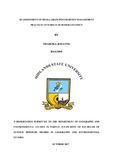Please use this identifier to cite or link to this item:
https://cris.library.msu.ac.zw//handle/11408/3465| Title: | An assessment of small grain post-harvest management practices in ward 22 of Buhera district | Authors: | Ndaboka, Johanne | Keywords: | Post-harvest management practices Small grains |
Issue Date: | 2017 | Publisher: | Midlands State University | Abstract: | The research was carried out to assess small grain Post-Harvest Management practices in ward 22 of Buhera district. A case study research design was used and the research employed both quantitative and qualitative research approaches. Two stage of multistage sampling technique was used. For the first stage, primary sample units (villages) were drawn randomly from all the villages in Ward 22 and for the secondary sample units, stratified random sampling was used to select households for questionnaires. Purposive sampling was employed to select key informants from World Vision, AGRITEX, GMB and the Ward Councillor. A combination of questionnaires, interviews, measurements and observation were used to collect data from the field. Data collected from the field was analysed using Statistical Package for Social Sciences (SPSS) and Microsoft excel. Results of this study showed that indigenous Post-Harvest Management practicessuch as use of chaff, Mutikiti leaves and crushed barks, dung and ashes at storage stage,bare ground, ruware, and stalksat drying stage and beating and cattle trampling at threshing stage are currently being used in Ward 22 of Buhera district. It was also shown that these indigenous technologies are susceptible to pests, termites, moulds and incomplete threshing. The results revealed a worrying lack of modern day Post-Harvest Management technologies which have proved to be a solution towards Post-Harvest Loss reductions. The findings established that lack of required resources such as cattle, scorch-carts, labour, and money are the major constraints hindering adoption of modern day technologies. Results revealed that food is being eliminated from food supply chain through decay, germination, scattering and damage. It was also revealed that, pertaining to level of Post-Harvest Loss, there was an underestimation of loss from self-reported loss estimations. However, findings of this research found that there is a strong correlation between household head type and level of loss. The researcher recommends that there is a need for the NGOs and the government to initiate exotic post-harvest technologies aimed at equipping the farmers both with sophisticated tools and equipment and modern day knowledge through awareness creation and training. There is also a need for continual quantification of on-farm loss which can be compared to costs of adopting improved post-harvest practices. | URI: | http://hdl.handle.net/11408/3465 |
| Appears in Collections: | Bsc Geography And Environmental Studies Honours Degree |
Files in This Item:
| File | Description | Size | Format | |
|---|---|---|---|---|
| r141340x.pdf | Full Text | 2.35 MB | Adobe PDF |  View/Open |
Page view(s)
84
checked on Feb 26, 2025
Download(s)
34
checked on Feb 26, 2025
Google ScholarTM
Check
Items in MSUIR are protected by copyright, with all rights reserved, unless otherwise indicated.


